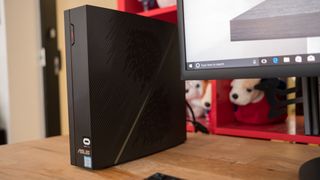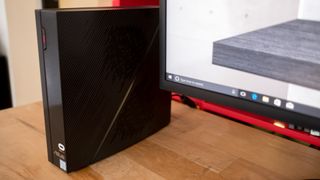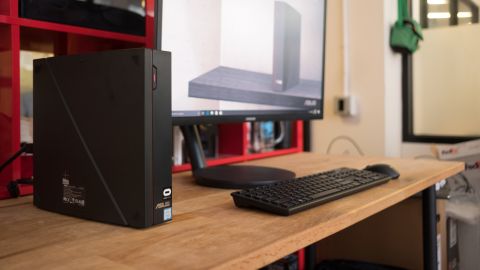TechRadar Verdict
The Asus VivoPC X gets you into VR without breaking the bank, but you may need to spend extra for a smoother experience.
Pros
- +
Lightweight and portable
- +
Supports VR headsets
- +
Affordable
Cons
- -
Slow hard drive
- -
No front USB ports
- -
Loud fans
Why you can trust TechRadar
It’s probably safe to say that virtual reality hasn’t taken off the way many hoped it would, and a big reason for that is the prohibitive price point for the hardware. Not only are users expected to spend up to $800 for a headset, but they need a $1,000+ PC on top of that to run the hardware.
It’s an expense that few are willing to commit to, given the newness of the technology, so it has become a top issue for hardware manufacturers to address.
That has led to a major shift to affordable and very capable gaming computers such as the Asus VivoPC X, which is best described as an entry-level VR PC. This mini desktop is roughly the same size as a gaming console such as the Xbox One or PlayStation 4, and it even has a console-like aesthetic with its rounded exterior.

Inside, the VivoPC X sports an Nvidia GeForce GTX 1060 video card, an Intel Core i5 2.5Ghz processor, 8GB of memory and a 1TB hard drive. Although the hardware specs aren’t likely to knock anyone’s socks off, they’re enough to power quality VR experiences – all at a relatively low $799 or £889 price tag.
The good news is that despite the low price, the GeForce GTX 1060 is enough to push high frame rates at high-quality settings for many modern games, including Overwatch, Prey, and Grand Theft Auto V. The bad news is that some of Asus’ design choices clearly marks the system as a budget PC.

Here is the Asus VivoPC X configuration sent to TechRadar for review:
CPU: 2.5Ghz Intel Core i5-7300HQ, (quad-core, 6MB cache, up to 3.5Ghz)
Graphics: Nvidia GeForce GTX 1060, 3GB DDR5 memory
RAM: 8GB DDR4 (2,400Mhz)
Motherboard: ASUSTek M80CJ-O
Power Supply: 230W
Storage: 1TB hard drive (5,400 rpm)
Optical drive: None
Ports: 4 x USB 3.1, 2 x USB 2.0, 2 x HDMI, DisplayPort, headphone jack, microphone jack, optical out, RJ45 Gigabit LAN
Connectivity: 802.11ac Wi-Fi, Bluetooth 4.1
Operating system: Windows 10 Home 64-bit
Weight: 4.85 pounds (2.2 kg)
Size: 2.99 x 11.02 x 10.23 inches (7.59 x 28 x 26cm; W x D x H)
Price and availability
With a starting price of $799 or £889 and the ability to run Prey 80-100 fps (frames per second) at its highest settings, there isn’t a whole lot to complain about. You will certainly be able to play games like Overwatch and Resident Evil 7 at a super-smooth 100 fps.
In Australia, the VivoPC X gets a speed boost with a 256GB SSD, though, it’s also more expensive at AU$1,599.
If you’re looking to dive into VR, then this little desktop is more than up for the task. The SteamVR performance test rates it perfectly for high quality VR experiences at 90fps or more.
Design
The VivoPC X’s design is clearly meant to invoke a console-like feel, with the ability to both stand vertically or lay flat. The little desktop is also fantastically light, weighing about 5 pounds (2.2 kg), making it easy to carry around and bring to events and parties so that it be hooked up to televisions.
But at the same time, the Asus VivoPC X has a few budget underpinnings that rub against its positioning as a gaming machine. This is immediately apparent upon unpacking the computer and finding a tiny wireless mouse and keyboard setup, neither of which are especially good for gaming beyond a very casual level.

Furthermore, the cooling fans can get very loud during intense gaming sessions. They’re noisy enough to be heard from up to four or five feet away. These may be minor nuisances, but they all add up to a sub-optimal experience.
For example, the VivoPC X is certified to support the Oculus Rift headset, which is demonstrated by how it has four USB 3.1 ports, two HDMI ports, and one DisplayPort to hook up multiple screens and a headset. However, all the USB ports are on the back. So, depending on where you keep the desktop, simple tasks like plugging in a memory stick can become a hassle.
The design expects that you’ll be in a headset using VR touch controllers most of the time, which assumes too much. Once you take that headset off – presuming that you have one to start with – then the VivoPC X’s usability flaws really start to show.

Upgradability
Unlike what you might expect from a gaming PC, there isn’t much room inside the VivoPC X for upgrades. The system can be configured with a 3.5Ghz quad-core processor with 6MB cache, up to 16GB of memory, and an SSD of no specific size, but the video card model is fixed to a single part.
The only way of adding additional graphical power is through Asus’ ROG XG Station 2 external graphics dock. The only problem is this GPU box isn’t available in the US and adds an £479 or AU$949 expense for a unit that doesn’t include a graphics card.
Storage and memory upgrades, however, should make the VivoPC X an excellent mid-level gaming PC and may make up for some of the base model’s major shortcomings.

Here’s how the Asus VivoPC X performed in our suite of benchmark tests:
3DMark: Sky Diver: 20,811; Fire Strike: 9,002; Time Spy: 3,537
Cinebench CPU: 512 points; Graphics: 86 fps
GeekBench: 3,865 (single-core); 10,475 (multi-core)
PCMark 8 (Home Test): 3,449 points
Deus Ex: Mankind Divided: (1080p, Ultra): 11 fps; (1080p, Low): 80 fps
GTA V: (1080p, Ultra): 75 fps; (1080p, Low): 139 fps
Performance
The performance level of the VivoPC X can be a real paradox.
Generally speaking, the mini desktop runs most games beautifully at very high settings, although you won’t always be able to crank everything up to Ultra. However, Asus makes a terrible mistake with its 1TB hard drive model, which uses a 5400 rpm spinning drive.
Having a slow hard drive with 8GB of memory and a Core i5 processor that’s usually used in notebooks means that doing almost everything takes forever. Installing and starting games, loading levels, and even booting up Windows 10 takes a painfully long time.
The consequences are most apparent with fighting games such as Tekken 7, where players are stuck waiting while an arena loads. Additionally, the background animations end up stuttering as the system struggles to load up the match. This problem also occurs in open world games such as Grand Theft Auto V, where the landscape may stutter as it is being loaded.

What makes the issue downright infuriating is how it can undermine the GeForce GTX 1060 video card, which performs exceptionally well for most games. So, while the actual Tekken 7 matches might play wonderfully at 60fps, the wait between matches can become a huge drag.
The VivoPC X’s video card provides excellent performance, even though games like Deus Ex: Mankind Divided will definitely put a strain on it. But the rest of the hardware for the base model doesn’t match up with it very well.
Upgrading to a faster hard drive, more memory and possibly a faster processor almost becomes a necessity, since the better experience might be worth the extra money, especially if you’re investing in a VR setup. You don’t want to be stuck waiting while your VR world loads.

Final verdict
In one sense, the Asus VivoPC X accomplishes what it sets out to do, which is to provide a relatively low-cost solution for people who want VR experiences without putting too much hurt on their wallets. On the other hand, you’ll need to spend extra money if you want a smooth gaming experience (not to mention a better keyboard and mouse) which creates quite a catch-22.
Still, if you’re in the segment of people who are looking for a gaming PC with VR support that costs less than a grand, then the Asus VivoPC X certainly gets the job done. Just be prepared to spend a long time staring at loading screens.

